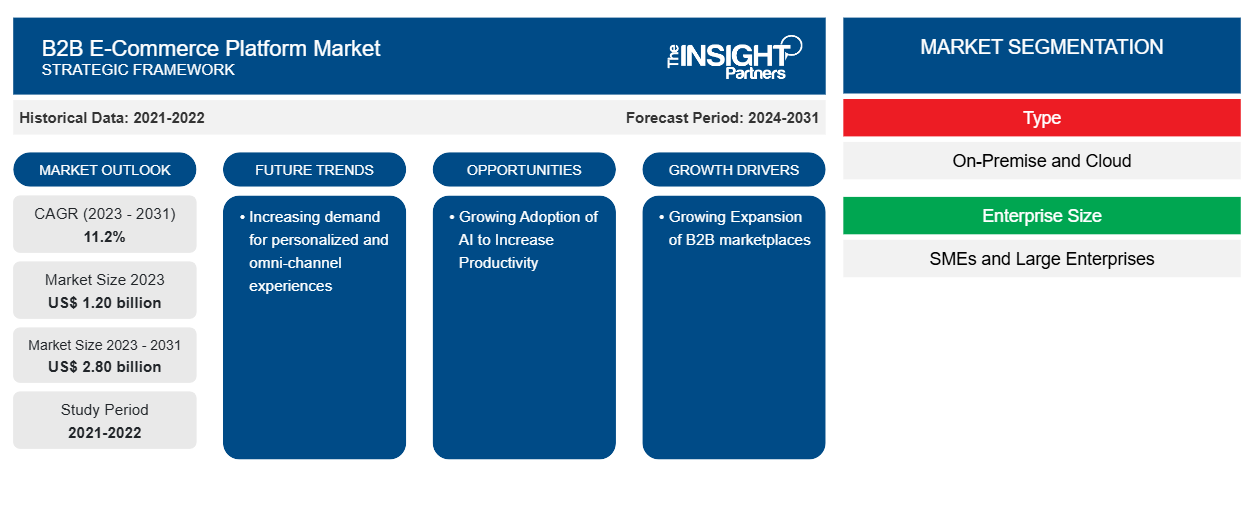B2B 電子商取引プラットフォーム市場規模は、2023 年の 12 億米ドルから 2031 年には 28 億米ドルに達すると予測されています。市場は 2023 年から 2031 年にかけて 11.2% の CAGR を記録すると予想されています。パーソナライズされたオムニチャネル エクスペリエンスに対する需要の増加は、B2B 電子商取引プラットフォーム市場の主要なトレンドであり続けると思われます。
B2B Eコマースプラットフォーム市場分析
多くの企業がデジタル技術を利用して、顧客体験の向上、効率性の向上、プロセスの自動化を行っています。スマートフォンの普及と高速インターネット ネットワークの継続的な開発により、企業にとってオンライン ビジネスはより容易になっています。その結果、利用できる B2B 電子商取引プラットフォームが増え、企業は顧客やパートナーと簡単かつ効果的にコミュニケーションできるようになりました。同時に、進行中のグローバル化により、企業は世界中の顧客やベンダーとB2B電子商取引を行うことができるようになり、国際貿易が活発化しています。
B2B Eコマースプラットフォーム市場概要
B2B(企業間)商取引は、企業から消費者(B2C)への取引ではなく、企業間での商品、サービス、または情報の交換です。B2B取引は、インターネット小売業者と卸売業者など、2つの企業間で行われます。パンデミックの蔓延は、ほとんどの企業がさまざまな制限に従わなければならないため、近年の市場の成長を後押しする主な要因の1つでした。さらに、B2B分野に参入するミレニアル世代の増加も、B2B eコマースプラットフォーム市場の成長を後押ししています。
要件に合わせてレポートをカスタマイズする
このレポートの一部、国レベルの分析、Excelデータパックなど、あらゆるレポートを無料でカスタマイズできます。また、スタートアップや大学向けのお得なオファーや割引もご利用いただけます。
-
このレポートの主要な市場動向を入手してください。この無料サンプルには、市場動向から見積もりや予測に至るまでのデータ分析が含まれます。
B2B Eコマースプラットフォーム市場の推進要因と機会
B2Bマーケットプレイスの拡大
B2B ベンダーは、サードパーティの電子商取引プラットフォームを使用して、リーチを拡大し、競争を評価し、Amazon Business や Alibaba.com などのマーケットプレイスを使用して購入するバイヤーに利便性を提供します。B2B マーケットプレイスは、比較ショッピング、顧客評価、製品レビューなどのリソースをバイヤーに提供します。このため、Google によると、B2B バイヤーの 80% 以上がデジタル コマース チャネルを介して注文または支払いを行うことを好みます。したがって、B2B マーケットプレイスの拡大が、B2B 電子商取引プラットフォーム市場の成長を促進しています。
生産性向上のための AI 導入の増加
Salesforce, Inc. によると、B2B 企業の 32% が AI を完全に統合していますが、約半数 (45%) はまだ実験段階にあります。企業はすでに、従業員の生産性と運用効率の大幅な向上に気づいています。さらに、AI は、B2B デジタル変革の以前は問題だった領域を大幅に強化する能力を持っています。AI は、これらのタスクに必要な手作業の量を大幅に削減する可能性があります。生成 AI により、企業は在庫をデジタルでより多く表示できるようになりました。また、多くの企業が、視覚的な購入体験など、さらに複雑な製品資料に拡大できるようになります。したがって、AI の採用の増加により、予測期間中に B2B e コマース プラットフォーム市場の成長の機会が生まれることが期待されます。forecasted period.
B2B Eコマースプラットフォーム市場レポートセグメンテーション分析
B2B 電子商取引プラットフォーム市場分析の導出に貢献した主要なセグメントは、タイプ、企業規模、およびエンドユーザー業界です。
- タイプに基づいて、B2B Eコマースプラットフォーム市場はオンプレミスとクラウドに分類されます。オンプレミスセグメントは2023年に大きな市場シェアを占めました。
- 企業規模に基づいて、市場は中小企業と大企業に分割されています。大企業セグメントは2023年に大きな市場シェアを占めました。
- エンドユーザー産業に基づいて、市場は自動車、電気・電子、一般産業、その他に分類されます。自動車セグメントは、予測期間中に大幅な成長が見込まれます。
B2B Eコマースプラットフォームの地域別市場シェア分析
B2B 電子商取引プラットフォーム市場レポートの地理的範囲は、主に 5 つの地域に分かれています。北米、アジア太平洋、ヨーロッパ、中東およびアフリカ、南米/中南米。
アジア太平洋地域では、B2B 電子商取引プラットフォーム市場の大幅な成長が見込まれています。この地域の市場は、オーストラリア、中国、インド、日本、韓国、およびその他の APAC に分割されています。この地域、特に中国、日本、インドの工業化と都市化の拡大は、市場の拡大を後押しする可能性があります。また、国際航空運送協会 (IATA) によると、APAC は世界の電子商取引市場の成長をリードしており、中国が成長のかなりの割合を占めています。国際貿易局によると、中国の電子商取引市場は世界最大であり、世界の取引のほぼ 50% を生み出しています。さらに、インドブランドエクイティ財団 (IBEF) によると、インドの電子商取引市場は 2025 年までに 1,880 億米ドルに達すると予想されています。したがって、この地域で成長する電子商取引セクターは、B2B 電子商取引プラットフォーム市場の成長を促進しています。
B2B Eコマースプラットフォーム市場地域別分析
予測期間を通じて B2B Eコマース プラットフォーム市場に影響を与える地域的な傾向と要因は、Insight Partners のアナリストによって徹底的に説明されています。このセクションでは、北米、ヨーロッパ、アジア太平洋、中東およびアフリカ、南米および中米にわたる B2B Eコマース プラットフォーム市場のセグメントと地理についても説明します。

- B2B Eコマースプラットフォーム市場の地域別データを入手
B2B Eコマースプラットフォーム市場レポートの範囲
| レポート属性 | 詳細 |
|---|---|
| 2023年の市場規模 | 12億ドル |
| 2031年までの市場規模 | 28億ドル |
| 世界のCAGR(2023年~2031年) | 11.2% |
| 履歴データ | 2021-2022 |
| 予測期間 | 2024-2031 |
| 対象セグメント |
タイプ別
|
| 対象地域と国 |
北米
|
| 市場リーダーと主要企業プロフィール |
|
市場プレーヤーの密度:ビジネスダイナミクスへの影響を理解する
B2B Eコマース プラットフォーム市場は、消費者の嗜好の変化、技術の進歩、製品の利点に対する認識の高まりなどの要因により、エンドユーザーの需要が高まり、急速に成長しています。需要が高まるにつれて、企業は提供内容を拡大し、消費者のニーズを満たすために革新を起こし、新たなトレンドを活用し、市場の成長をさらに促進しています。
市場プレーヤー密度とは、特定の市場または業界内で活動している企業または会社の分布を指します。これは、特定の市場スペースに、その市場規模または総市場価値に対してどれだけの競合相手 (市場プレーヤー) が存在するかを示します。
B2B 電子商取引プラットフォーム市場で事業を展開している主要企業は次のとおりです。
- アプタス株式会社
- BigCommerce株式会社
- アリババ
- キボコマース
- マグネト IT ソリューションズ株式会社
- オンデマンドソリューションズ株式会社
免責事項:上記の企業は、特定の順序でランク付けされていません。

- B2B Eコマースプラットフォーム市場のトップキープレーヤーの概要を入手
B2B Eコマースプラットフォーム市場のニュースと最近の動向
B2B Eコマース プラットフォーム市場は、重要な企業出版物、協会データ、データベースを含む一次調査と二次調査後の定性的および定量的データを収集することによって評価されます。以下は、市場の動向の一覧です。
- シェフラーAGの子会社であるシェフラー・インディア・リミテッドは、KRSVイノベイティブ・オート・ソリューションズ・プライベート・リミテッド(以下、「KRSV」)の株式100パーセントを取得する株式購入契約を締結しました。KRSVはベンガルールに本社を置き、急成長中のB2B eコマースプラットフォームであるKooversを通じてインドのアフターマーケットワークショップに修理ソリューションを提供しています。Kooversは、シェフラー・オートモーティブ・アフターマーケットのインドでの活動に理想的な追加です。(出典:シェフラー、プレスリリース、2023年)
- 急成長中の確立された B2C および B2B ブランド向けの主要なオープン SaaS 電子商取引プラットフォームである BigCommerce は、BigCommerce マーチャントに次世代の B2B 機能を提供する長年の BigCommerce テクノロジー パートナーである BundleB2B の買収を発表しました。(出典: Intertek、プレス リリース、2021 年)
B2B Eコマースプラットフォーム市場レポートの対象範囲と成果物
「B2B Eコマースプラットフォーム市場規模と予測(2021〜2031年)」レポートでは、以下の分野をカバーする市場の詳細な分析を提供しています。
- 対象範囲に含まれるすべての主要市場セグメントの世界、地域、国レベルでの市場規模と予測
- 市場の動向(推進要因、制約、主要な機会など)
- 今後の主な動向
- 詳細なPEST/ポーターの5つの力とSWOT分析
- 主要な市場動向、主要プレーヤー、規制、最近の市場動向を網羅した世界および地域の市場分析
- 市場集中、ヒートマップ分析、主要プレーヤー、最近の動向を網羅した業界の状況と競争分析
- 詳細な企業プロフィール
- 過去2年間の分析、基準年、CAGRによる予測(7年間)
- PEST分析とSWOT分析
- 市場規模価値/数量 - 世界、地域、国
- 業界と競争環境
- Excel データセット
最新レポート
お客様の声
購入理由
- 情報に基づいた意思決定
- 市場動向の理解
- 競合分析
- 顧客インサイト
- 市場予測
- リスク軽減
- 戦略計画
- 投資の正当性
- 新興市場の特定
- マーケティング戦略の強化
- 業務効率の向上
- 規制動向への対応























 無料サンプルを入手 - B2B Eコマースプラットフォーム市場
無料サンプルを入手 - B2B Eコマースプラットフォーム市場